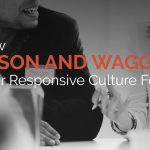How pulse surveys help your organization align and adapt in a time of rapid change.
SIOP 2017 is in full swing, which marks a year since Denison Consulting joined forces with Waggl to create a more dynamic and aligned method to drive culture change in high-performance organizations. To mark the anniversary, we put together a series of interview questions for Waggl CEO, Michael Papay, to ask for his perspective on how organizations can learn to adjust to rapid changes in their environment, and ways in which Denison and Waggl can help them develop high-performing cultures. Here’s what we wanted to know.
With Waggl, you spotted a gap in the way businesses conduct employee satisfaction surveys. How does Waggl fill that gap? What does it bring to the field that other culture surveys don’t?
Well, first we saw a need to increase the frequency. Checking in once a year or every other year is clearly not frequent enough. We know employees want to be heard and have more of a say. But we also know that employees aren’t wild about continuing to fill out surveys. So how do we make it a better experience?
To handle that challenge, we wanted to create a lighter, faster, and more consumer-like experience. One of the things we did differently is that we put the employee at the center of the design experience. If companies need more frequent feedback, what’s an experience people will want to come back to? So we focused on making the surveys feel more like a game, allowing employees to vote through colleagues’ answers, which adds an element of crowd sourcing.
We also focused on actionable insight. It’s not good enough to increase frequency and experience, it needs to culminate into action. We knew that the crowd sourcing aspect created a lot of transparency. And we worked on visualizing the results, which make them more actionable. You can see the progress you’re making as you drive change in your organization.
How frequently do you recommend businesses conduct pulse surveys?
I’d say the short answer is: at a rate at which they’re able to metabolize the results and translate them into action. Don’t move at a frequency that’s so high you can’t enact anything. The exact frequency at which organizations are able to do this will be relative to their initiative and size, but most of our organizations are using Waggl to check in on some area of their business at a rate of about 1.5 pulses per month.
At the same time, we’re beginning to see a best practice develop in which organizations set out a reduced set of questions every quarter to six months in order to establish a rhythm. If there’s a set of questions they’re going to repeat, they’ll usually do so once a quarter. Or if they’re looking at a very specific thing, they may probe into an area separately from their general question set. But the important thing is to establish a pace which allows them to gather and digest feedback in a timely manner so that they can track progress as they go.
What kind of response do you see in terms of employee engagement from these surveys?
We want employees to see Waggl as more than a survey, but as a two-way dialog. This is a chance to be authentically heard. When we get employees to engage, the proof is in the pudding. We find that when companies pilot Waggl with their workforce, employees come back with very positive feedback. They really value what the colleagues thought, they enjoy the transparency, and they feel rewarded and engaged.
Do you see pulse survey engagement translating directly to high-performance culture, or is there more to that process?
Well, I think there’s layers to it. Ultimately, what we’re doing is having a different conversation. We’re increasing transparency and consistency, which builds dialog and therefore trust. So organizations and leaders who are committed to our process build trust, and from that trust you can build a high-performing organization. If you don’t have a layer of trust, communication, and empathy, you’re never going to get the performance. So pulse surveys help build core values through which high-performing organizations can come to life.
Are there some survey questions that work better with Waggl than others?
We find that less is more and simpler is better. We even do simple yes/no questions, ones as straightforward as “do you feel this way or that way?” But simple questions can also be open-ended. This makes way for the crowd-sourcing element, which allows coworkers to vote on answers they like.
We have also seen questions that are more appreciative do very well. It’s a way of driving change with positive sources. Organizations can ask questions like “Where’s a case where you’ve done this really well, or seen a colleague do this really well?” People are more excited by this, and like seeing what their coworkers say. In general, we believe people like seeing more of the good stuff and less of the bad stuff. So we look at questions which are appreciative, empathetic, and open-ended. If I ask this audience a question, what can I ask that will draw out interest, engagement, and excitement? We believe the surveys become almost hyper-engaging when you make them positive and empathetic.
What do Waggl surveys primarily measure? Engagement? Satisfaction? Can they measure almost anything?
The Waggl pulse surveys can measure almost anything. However, we have developed a group of culture questions with Denison that we call the D12, which measure each of the twelve sections present on the Denison Model.
For instance, looking at strategy: where do you need to build strategic alignment in order to be on the nerve of what’s happening? I’ve found it staggering how industries as a whole are being disrupted about every 3.1 years. There’s rampant change and transformation going on. We know that change is constant, so being on the nerve is the new frontier. Organizations and individuals need to rewire themselves to be more agile, more flexible, and to be able to make decisions quickly. There’s a whole new skill set required these days, and there’s not enough discussion about how to adapt to this change.
That said, frequency is only one dimension. Real change requires people feeling like they’re part of it. It’s one thing for an organization to monitor how their people feel. But if they’re taking that information and making their employees part of the change, encouraging their response, and sharing the results in real-time, they’re sending a message to those employees that they are trusted to see the results of these questions. They’re empowered on the managerial or leader level to take action on it. And that’s a powerful message.
So helping employees feel that they’re part of the change process and being empowered to act is an essential dimension. Change can’t be pushed from the top down anymore. Everybody has to own it. We use the D12 organizationally at Waggl every 3–6 months, and then we talk about it as a group. We all own it together. When 30–40 people are going to work on this data, it’s no longer a “me” thing but an “us thing.”
We talked recently on the blog about culture climate, and how that can be affected by the mindset employees bring to work and the way in which they interact with coworkers. One thing we talk about is how climate is more changeable, and in some senses, more fickle than culture. Is there a chance that pulse surveys may capture too much of the climate—i.e., a changeable mood that could be a result of the weather or some temporary stress—and not enough of the real culture?
I do think we have to be careful with the data we collect. Organizations shouldn’t get too caught up in one data point, but I see a time where constant collection is going to be the norm. The good news is that, through collecting more data, organizations can examine it through a wider lens. There is more leveling and averaging it out, month over month. The results go up and down, but they help to counteract temporary mood swings.
Do you have anything more to share?
To return to the story of change, we believe that change is the new normal. New jobs are appearing overnight, while at the same time whole industries are being replaced. We have to accept that change is the constant in our personal lives and our personal careers. But through better tools, better mindsets, and better communication, we can actually thrive rather than just survive in change.
At Waggl, we come from a belief that work should be more fun, more human, more engaging. We shouldn’t settle for just survival, but rewire our processes and ourselves to really thrive. Dension has an incredible model which shows that, without the right culture in place—the right values and behaviors—you’re never going to get to thrive no matter what an individual’s engagement. Culture is the bedrock of that.
We see Denison and Waggl as being complimentary. Denison provides an aspect which is not dissimilar to a CFO, in that it’s important to have the long view. But it’s more mature to complement that with something more timely, so that the measures of success are not just annual. We believe Denison has a best-in-breed model, in an area that’s really critical for companies to pay attention to. And then you compliment that with Waggl, which is this fast and flexible tool, and you have a chance to see where your company has materially moved the needle on culture.






